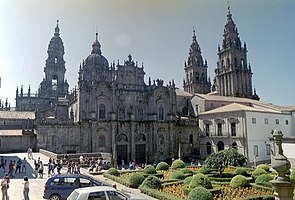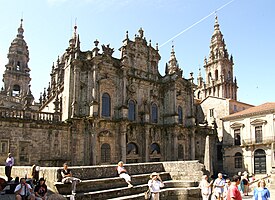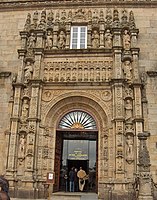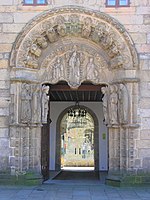.jpg/300px-Santiago_de_Compostela,_Galiza_(cropped).jpg) | ||
| Santiago de Compostela | ||
| region | Galicia | |
|---|---|---|
| Residents | 97.848 (2020) | |
| height | 260 m | |
| no tourist info on Wikidata: | ||
| location | ||
| ||
Santiago de Compostela is a place of pilgrimage in spanishGalicia with the for World heritage belonging cathedral.
background
The namesake of the city is Saint Jacob (Sant Jago), whose grave is believed to have been found in the 9th century by a hermit on a field of stars (Latin: Campus stellae> Compostela). Shortly thereafter, a settlement was established that quickly grew into a city. Santiago became a spiritual center of the struggle against the Moors, which is why the general Almansor was sent to Compostela in 997 by the Emir of Córdoba. This did not hesitate and destroyed the 100-year-old pillar basilica with the surrounding buildings. But the city recovered quickly from this stroke of fate. The Romanesque cathedral was built on the site of the destroyed basilica as early as 1188. With the Reformation in Europe, the pilgrimage to Santiago dwindled and the city became more and more a marginal phenomenon. This changed in the late 18th century when pilgrims began to travel to Santiago again. The Franco regime used the city and its saint for propaganda purposes. From 1933, a donation to the cathedral was introduced by law. In 1981, when Galicia was given the new autonomy status, the seat of the President and the Galician Parliament was established here, although Santiago is administratively subordinate to the provincial capital A Coruña.
getting there
By plane

Shuttle buses run between the city center and the airport every 30 minutes. The bus runs in Santiago from the “Rúa do Doutor Teixeiro” stop from 6:00 am to midnight and also stops at the “Plaza de Galicia” and am 2 Bus station. From the airport to Santiago the first shuttle bus leaves at 6.45am and the last one at 0.45am. The trip costs € 3, a return ticket € 5. Status: September 2015.
The airport can be reached from the city center by private or rental car via the N 634a can be achieved.
By train
Santiago de Compostela has one 3 railway stationwhich is south of the old town at the end of the Rúa do Hórreo lies. Trains of the stop there almost every hour Renfe from, to A Coruña (Journey time approx. 30 minutes), Ourense (40 minutes), also seven times a day from / to Vigo (Travel time 1½ hours).
In long-distance traffic, Alvia high-speed trains stop to / from three times a day Madrid-Chamartín (5 hours) and an Intercity from Irun on the Spanish-French border and Donostia / San Sebastian (10½ hours) via Burgos (7½ hours) and Leon (5:15 hrs).
You can arrive extremely luxurious with the special tourist trains of the Transcantábricowhose week-long tours of Northern Spain always stop here.
By bus
- Among other things, international buses run by AS A to and from a large number of cities also in the German-speaking area.
In the street
Of A Coruña the Autobahn leads out ![]() Autopista AP-9 (E1) at the city Santiago over to after Vigo and to the border after Portugal, parallel to this is the one that is not subject to the toll N-550.
Autopista AP-9 (E1) at the city Santiago over to after Vigo and to the border after Portugal, parallel to this is the one that is not subject to the toll N-550.
Of Lugo in the east resp. of the ![]() Autovía A-6 from leads the N-540 southwest, until after 16 km on the N-547 You have to change to dan from the east Santiago de Compostela to reach. The N-547 ends in the
Autovía A-6 from leads the N-540 southwest, until after 16 km on the N-547 You have to change to dan from the east Santiago de Compostela to reach. The N-547 ends in the ![]() Autovía del Aeroporto A-54 to the city center.
Autovía del Aeroporto A-54 to the city center.
The toll one ![]() Autopista AP-53 leads in a south-easterly direction to Ourense, where it joins the westward
Autopista AP-53 leads in a south-easterly direction to Ourense, where it joins the westward ![]() Autovía A-52 in the direction Leon leads. It is accompanied by the one that does not have to pay a toll N-525.
Autovía A-52 in the direction Leon leads. It is accompanied by the one that does not have to pay a toll N-525.
The AG-56 resp. the one under construction CG-1.5 and parallel the AC-543 lead westward to Noia at the Ría de Muros and on towards Fisterra.
By bicycle
Santiago is the end point of the European long-distance cycle route EuroVelo 3 (also known as the “pilgrim route” or “La Scandibérique”), which leads here from Scandinavia through northwest Germany, Belgium and France. The Spanish post office offers the service of sending the bike back in transport packaging.
On foot
The traditional way to get to Santiago de Compostela is by walking Pilgrimage route (Way of St. James). Here is the end of all the Camino de Santiago: Camino Francés from the French border in the Pyrenees, Camino del Norte along the Spanish north coast, Camino de Madrid, Caminho Português from Lisbon and the Camino a Fisterra from / to Cabo Fisterra at the western end of mainland Europe.
mobility
The old town is traffic-calmed and therefore exploring on foot is almost inevitable. Most of the sights are, however, located within the old town and can be reached within a few minutes. There are several well-signposted parking lots near the old town, such as Platz an der 5 Av. de Xoán XXIII. There are also public toilets in the parking garage
A municipal bus network with approx. 20 lines is operated by the municipal bus company TUSSA to chat. Many of the bus stops are not recognizable as such, it is helpful to ask locals for the nearest bus stop. To make matters worse, the bus stops are not announced.
Tourist Attractions
Streets and squares

To the 1 Praza do Obradoiro are the cathedral, the Seat of the Galician President, the Episcopal Palace and the Hostal dos Reis Católicos (today state hotel Parador Nacional), which already mentions 5 of the city's most important sights. They are surrounded by the alleys of the old town with picturesque houses, often with typical glazed balconies.
Churches
Santiago has 15 churches, the most important of which is the Romanesque cathedral, completed in 1120, with two 78 m high towers, a three-aisled transept and the alleged tomb of the Apostle James (the Elder), the patron saint of Spain, plus several former monasteries.
cathedral


- 2 Santiago de Compostela Cathedral. It is at least the third sacred building erected at this point. The construction of today's cathedral began around 1075/77. Initially planned as a Romanesque cathedral, during the long construction period - as was customary - the building was modified in the current styles.
It became the UNESCO World Heritage Site explained. The Obradoiro facade is the west facade to Praza do Obradoiro. It was completed in the 18th century and is in the opulent Baroque style. It now covers the earlier facade, of which only the glory portal has survived.
The north tower will Carraca named, the south tower Campanas (Bell tower). Both have a structure in the Baroque style on the lower Romanesque tower part.
The Praterías facade is the south facade of the cruise ship. It is the only facade on which the Romanesque structure has been preserved.
The Clock tower (Torre del Reloj) was built in the 16th century and is the work of Rodrigo Gill de Hontañón; it is located in the southeast corner of the south aisle. At the southeast corner of the southern extension is the Treasure tower (Torre del Tesoro).
This is on the east side King portal and the Holy door. The holy gate (Puerta Santa) is the second from the right on the east side of the cathedral, it is only open during the Compostelan Holy Year. This festival has been celebrated since the 12th century in the year in which the apostle's name day, July 25th, falls on a Sunday. It always lasts from the afternoon of December 31st to the next December 31st.
On the north side is the Azabachería facade to the place of the same name. It used to be called the Paradise Facade. This ends here French Way of St. Jameswhich is the most popular. This facade contains the first classicist elements that were used in Compostela.
The Interior of the cathedral is from Main altar, which is located above the tomb of the apostles, dominates.
Behind the Main altar is accessible via a side gate with a few steps Camarín (St. Jacob's niche), in it is the seated statue of James as the master. It is customary for pilgrims to embrace the statue after completing their duties. This is why the stone statue has a halo, as many put their hats on his head in order to be able to hug him better. It is a strange spectacle when the flow of pilgrims behind the statue of James on the main altar does not stop even during mass.
Another specialty is that Botafumeiro. The huge incense burner hanging on a rope is set in motion by a powerful team and swings far up to the roof of the transept.
In the crypt, behind the main altar, is the tomb of Jacob and his two companions Athanasios and Theodoros.
The Glory portal is now covered by the Obradorio facade. The richly decorated portal was designed by his court architect Mateo on behalf of Ferdinand II. The portal reflects the belief Fellow citizens of the saints and housemates of God are built on the foundation of the apostles and prophets contrary. The center is dominated by a seated Jesus almost three meters high, with the four evangelists on guard.
Guided tours through the cathedral (such as the roof tour) must e.g. T. be reserved in advance, this can on-line or on site. Pilgrims with a pilgrim's pass receive a discount.
Castles, chateaux and palaces

- The 3 Hostal dos Reis Católicos was built as a pilgrim hospice in 1498 by the Catholic kings. Today it houses the most famous and most expensive Parador in Spain. This is a state-owned 5-star hotel. It is located on the north side of the Praza do Obradoiro.
- The 4 Pazo de Raxoi is the seat of the Galician President. It dates from 1777 and is located on the west side of Praza do Obradoiro.
- The 5 Pazo de Xelmíres (also Palacio de Arzobispo) dates from the 12th / 13th centuries. Century. The Romanesque building has a 32 meter long and 8 meter wide ballroom and is often used for aristocratic weddings. The building can be visited. It is located on the southern side of Praza do Obradoiro. (Opening times: Tue-Sun 10: 00-13: 30 and 16: 30-19: 30)
Monuments
- Horse fountain, in the Plaza de Platerías.
Museums
- 6 Museo do Pobo Galego (Archaeological Museum) (Museo del Pueblo Gallego). Tel.: 34 981-583620, Fax: 34 981-554840, Email: [email protected]. Open: 10: 30-14: 00/16: 00-19: 30, Sun 11: 00-14: 00.Price: 3.00 / 1.00 €.
- 7 Cathedral Museum (Museo Catedral), Catedral de Santiago (Entrance in the cathedral, in the right aisle). Open: 09: 00-20: 00 (winter 10: 00-20: 00).
- 8 Pilgrim Museum (Museo das Peregrinacións), Rúa de San Miguel, 4th floor. Tel.: 34 981581558, Fax: 34 981581955, Email: [email protected]. Closed due to relocation until November 2015.Open: 09: 00-14: 30.
- 9 Centro Galego de Arte Contemporánea (modern art) (Centro Gallego de Arte Contemporáneo), Rúa Valle Inclán. Tel.: 34 981 546619, Fax: 34 981 546625, Email: [email protected]. Open: 11: 00-20: 00.
- 10 Museo Centro Gaias (Ciudad de la Cultura de Galicia), Cidade da Cultura de Galicia, Edificio Museo Centro Gaiás, Monte Gaiás. s / n, 15707 Santiago de Compostela, La Coruña, Spain.
Parks

- 11 Parque Alameda with the lookout point 12 Miradoiro de Catedral
- 13 Caraballeira de Santa Susanana (Carballeira de Santa Susana, Santiago de Compostela). Oak grove at the Santa Susanna chapel, it connects to the Parque Alameda,
- The two Marias of Santiago de Compostela, two statues at the entrance of the park. The two sisters went for a walk in the park every day at 2:00 am and showed their knowledge of the Franco regime.
various

in the 6 Pilgrims office in the Casa do Deán in Rua do Vilar, those who have completed the last 100 km of the Way of St. James to the cathedral on foot or the last 200 km by bike or on a mount, after presenting the stamped pilgrim passport, the pilgrimage certificate that Compostela.
activities
- A German-language mass is celebrated in a side chapel within the cathedral every day during the pilgrimage season at 8 a.m.
- German-speaking pilgrim pastoral care in Santiago de Compostela. During the pilgrimage season, the pilgrim chaplaincy offers a guided tour (so-called "spiritual tour") around the cathedral every day at 7:00 pm (from October 1st: 6:00 pm). The meeting point is the north portal.
Festivals
- Ascencion. In the week around Ascension Day there is the park on the hill Alameda a kind of fair with many rides especially for children and a big ferris wheel on the hill that towers over the city.
shop

Numerous shops selling, among other things, souvenirs and devotional items can be found in the pedestrian zone around the Rua do Vilar. Supermarkets in Santiago de Compostela are closed on Sundays.
Markets
- 1 Mercado de Abastos. The market halls can be found in the Rua Ameás on the eastern edge of the old town.Open: Mon - Sat 8:00 a.m. - 3:00 p.m., although not all stands are always open.
kitchen
- Tarta de Santiago is an almond cake with a cross of St. James (Cruz de Santiago) on top. This is sprinkled with powdered sugar and the cross is omitted. The cake consists of almonds, sugar, eggs, grated lemon peel and, of course, powdered sugar, and some even add a sip of liqueur.
.jpg/220px-Tarta_de_Santiago_(4467497071).jpg)
Tarta de Santiago
nightlife
accommodation


Cheap
Pilgrims who have covered the last 100 kilometers on foot or the last 200 kilometers by bike or horse can spend the night here cheaply:
- Seminario Menor, Avda. Quiroga Palacios. Tel.: 34 981 589 200, Email: [email protected]. 60-300 beds.Price: Dormitory: € 12; Single room: 15 €.
- San Lázaro hostel. Tel.: 34 981 571 4881. about 80 beds; max. 3 nights possible.Price: first night: € 10, subsequent nights: € 7.
- Albergue Juan XIII, Rúa des Castineiros. E-mail: [email protected]. Refugio of the Franciscans, 25 mattresses.Price: donation.
- Hostels
medium
- 1 Nest Style Santiago, Rúa do Doutor Teixeiro, 15 15701 Santiago de Compostela, A Coruña, Spain. Tel.: 34 981 563 444, Fax: 34 981 589 653, Email: [email protected]. Open: 00: 00-24: 00.
Upscale
- NH Collection, Av. do Burgo das Nacións, s / n, 15705 Santiago de Compostela, A Coruña.
health
Practical advice
- 1 Tourism de Santiago, Rúa do Vilar, 63. Tel.: 34 981 555 129, Email: [email protected]. municipal tourist information.Open: 09: 00-19: 00, Sat / Sun 09: 00-14: 00/16: 00-19: 00.
- the 2 Main post office is located on the Rua do Franco, 4th floor
- Under the Pazo de Raxoi there is a police station and a public toilet
trips
- to the end of the world in Fisterra, where the Pilgrim's Way of St. James ends on the Atlantic coast for the most relentless pilgrims.
- to the beaches of the Rías Baixas
literature
Web links
- Tourist information from the tourist office (Spanish; other languages only with Javascript, Flash and popup windows)
- City administration (English), German short version
- Commercial site about sights and tourism




_4.jpg/133px-2010-Catedral_de_Santiago_de_Compostela-Galicia_(Spain)_4.jpg)














.jpg/240px-Catedral_de_Santiago_de_Compostela_agosto_2018_(cropped).jpg)













.jpg/220px-Tarta_de_Santiago_(4467497071).jpg)
